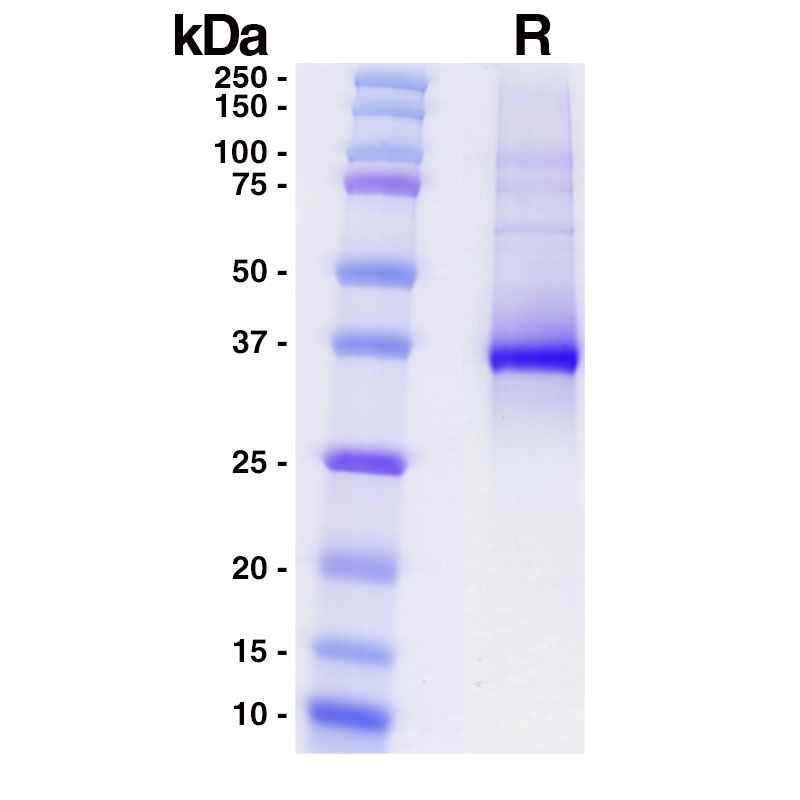Recombinant Chikungunya Envelope Protein E2 (strain SL-CK1)
| Code | Size | Price |
|---|
| LEI-C446-100ug | 100 ug | £335.00 |
Quantity:
| LEI-C446-500ug | 500 ug | £1,135.00 |
Quantity:
Prices exclude any Taxes / VAT
Overview
Host Type: Virus
Regulatory Status: RUO
Shipping:
Ambient
Storage:
1 month 2 to 8 °C. Sterile conditions after opening and reconstitution. 1 year from date of receipt -20 to -80 °C as supplied 3 months from date of receipt -20 to -80 °C. Sterile conditions after opening and reconstitution.
Images
Further Information
Conjugate/Tag/Label:
Purified No Carrier Protein
Format:
Lyophilized from 0.01M Phosphate Buffered Saline (150mM NaCl)(PBS) pH 7.4, with 5% Trehalose and 10mM DTT
Formulation:
Lyophilized from 0.01M Phosphate Buffered Saline (150mM NaCl)(PBS) pH 7.4, with 5% Trehalose and 10mM DTT
Long Description:
Chikungunya virus (CHIKV) is a mosquito-transmitted alphavirus that causes epidemics globally and has been declared a notable disease by the Centers for Disease Control and Prevention1, 2. Symptoms include high fever, myalgia, rash, and severe polyarthritis which can persist for long after acute infection. CHIKV is an enveloped virus with an 11.8-kb single-stranded, positive-sense RNA genome with two open reading frames3, 4. There are three main genotypes, having 95.2 to 99.8% amino acid identity: Asian, West African, and East/Central/South African (ECSA). The mature CHIKV virion is comprised of a nucleocapsid protein C and two glycoproteins, E1 and E2 5. E1 participates in virus fusion. E2 functions in attachment to cells. E1 and E2 form 80 trimeric spikes on the virus surface6. E2 localizes to the top of the spike and contains three domains: N-terminal domain A (center), domain B (tip), and C-terminal domain C (proximal to the viral membrane)5.
The SL-CK1 CHIKV strain was isolated from an epidemic in Sri Lanka in 2007 from a human source and has been fully sequenced (Genbank ID HM045801.1)7. Residue 18 of strain SL-CK1 E2 is a histidine8. This residue is an important determinant of virus fitness in mosquito cells.
Soluble recombinant CHIKV E2 protein has been used to generate monoclonal antibodies5.
NCBI Gene:
HM045801.1
Purity:
?90% by SDS PAGE
References
1. Barrera, R., Hunsperger, E., Lanciotti, RS. et al. Preparedness and response for chikungunya virus introduction in the Americas. Pan American Health Organization; National Center for Emerging and Zoonotic Infectious Diseases (U.S.). Division of Vector-Borne Diseases. 2011.
2. Silva, JVJ Jr., Ludwig-Begall, LF., Oliveira-Filho, EF. et al. Acta Trop. 188:213-224. 2018.
3. Powers, AM., Brault, AC., Tesh, RB. et al. J. Gen. Virol. 81:471?479. 2000.
4. Arankalle, VA., Shrivastava, S., Cherian, S. et al. J. Gen. Virol. 88:1967?1976. 2007.
5. Pal, P., Dowd, KA., Brien, JD. et al. PLoS Pathog. 9(4):e1003312. 2013.
6. Mukhopadhyay, S., Zhang, W., Gabler, S. et al. Structure. 14(1):63-73. 2006.
7. Volk SM, Chen R, Tsetsarkin KA, et al. J Virol. 84(13):6497-504. 2010.
8. Jupille HJ, Medina-Rivera M, Hawman DW, et al. J Virol. 87(10):5970-84. 2013.



